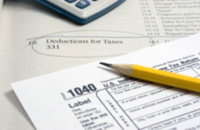Federal Income Tax Rental Property

It's that time of year again when the taxman wants to know how much you have earned and how much tax you owe him. Don't forget that your individual tax return has to be returned to the Internal Revenue Service (IRS) by April 15 this year, unless you have applied for, and received an extension. We all want to pay less tax, but instead of looking for loopholes and gray areas, rather focus on managing your tax affairs as efficiently as possible. The following business and personal tips should make the current tax year a little easier on your pocket when completing your return:
1. Travel Expenses It is good practice to keep a mileage logbook of distance travelled, in order to accurately determine you travel deduction. If you have two jobs, you can deduct the cost of traveling from the first to the second, but if you have a single job, you cannot deduct commuting costs because it is considered a personal expense, not a business expense. Travel for business, including costs to go to seminars and conferences are 100% deductible. Deductible travel costs include hotels, airfare, taxis, car rentals, parking fess, tolls and tips.
Appraisers lower costs for federal tax savings
Tax savings through cost segregation is no longer out of reach for investors in small and medium size properties. With appraiser expertise, fees for analysis are often one-third to one-half lower than those charged by traditional preparers. Several years ago a definitive court case ruled that tangible personal property included in an acquisition or in overall costs should be depreciated as personal property for asset recovery, using the old Investment Tax Credit principles to classify personal property.
This meant that owners of improved properties could distinguish between real property and personal property to depreciate component costs over varying useful lives. Basically, instead of depreciating an entire commercial property over 39 years, or residential roperty (single-family rentals or multifamily) over 27.5 years, certain components are correctly identified as depreciating in much less time. For about 135 items, useful life periods can be 5, 7 or 15 years. This is known as cost segregation.
The result of increasing depreciation is lower taxable income (which would have been taxed at 35%) and more income taxed at the capital gains rate (15%) when the property is sold. Furthermore, it works for any type of improved property.
Tax Reduction - a Result of Cost Segregation

Oommercial real estate owners are paying excess federal income taxes because they are not depreciating their property as quickly as they should. A cost segregation study allows property owners to both defer and reduce federal income taxes. Cost segregation increases depreciation (a non-cash deduction) for commercial real estate owners.
When properly performed by an appraiser with expertise in cost segregation, this is a conservative tax planning tool which reduces federal income taxes by properly allocating the cost basis between land, 5-year, 7-year, 15-year, 27.5-year and 39-year property. (Long-life depreciation is 27.5 years for residential rental properties and 39 years for commercial properties.
Carpet and vinyl tile are typical 5-year items. Site improvements such as landscaping and paving are 15-year items.)Depreciation is an important non-cash tax deduction. By increasing tax deductions,
commercial property owners affect federal income tax reduction. (Depreciation indirectly reduces income taxes by reducing taxable income. Income tax credits directly reduce income taxes.) The increase in tax write-offs generates such a large tax cut that some wonder if it is a tax shelter or tax evasion scheme. It is not. Cost segregation is an IRS-guided process used to increase tax deductions during